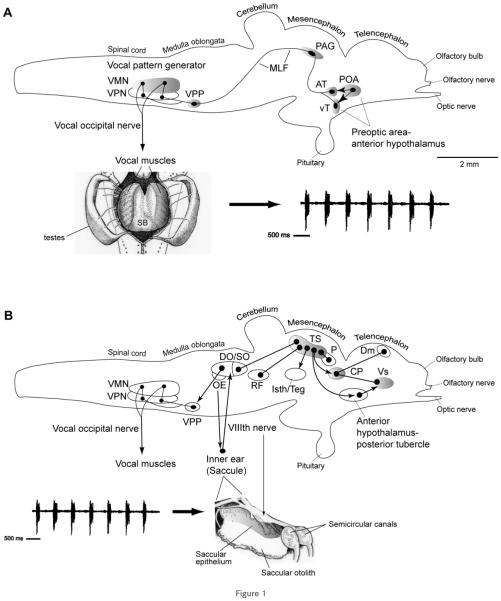Figure 1.
Side views of the brain showing vocal motor (A) and central auditory (B) systems in batrachoidid fish (midshipman and toadfish) (modified from Bass and McKibben, 2003; Kittelberger et al., 2006). Solid dots represent somata, and lines represent axonal projection pathways. Two connected dots indicate reciprocal connections. Shaded areas indicate localization of AR expression. A: Descending vocal motor pathways (see Bass and Baker, 1990; Bass et al., 1994; Goodson and Bass, 2002; Kittelberger et al., 2006). Preoptic (POA) and ventral (vT) and anterior (AT) tuberal nuclei in the hypothalamic forebrain project to the periaqueductal gray (PAG) in the midbrain which then connects to the vocal pattern generator (VPG) in the hindbrain-spinal cord. The VPG consists of vocal prepacemaker (VPP), pacemaker (VPN), and motor (VMN) nuclei. The VMN projects directly via occipital nerve roots to sound-producing muscles on the swim bladder (shown in ventral, dissected view). The arrow points to a vocalization produced by the swim bladder, a typical “grunt train” often produced during nest defense by a type I male (Brantley and Bass, 1994). B: Central auditory system (see Bass et al., 2000, 2001). Natural sounds, represented by a “grunt train,” are detected by the inner ear which projects via the VIIIth nerve to octaval nuclei in the hindbrain and further to the auditory midbrain torus semicircularis (TS). Shown are nuclei interconnected with TS. The dorsal thalamic central posterior nucleus (CP) contains reciprocal connections to the dorsomedial (Dm) and ventral supracommissural (Vs) telencephalon which also receives input from the anterior hypothalamus-posterior tubercle (for nomenclature, see Braford and Northcutt, 1983). TS and CP also connect to vocal motor nuclei in the forebrain (anterior hypothalamus and POA) and midbrain (PAG and isthmal/tegmentum), while auditory-recipient octaval nuclei in the hindbrain connect to the VPG (also see Bass et al., 1994; Goodson and Bass, 2002).

